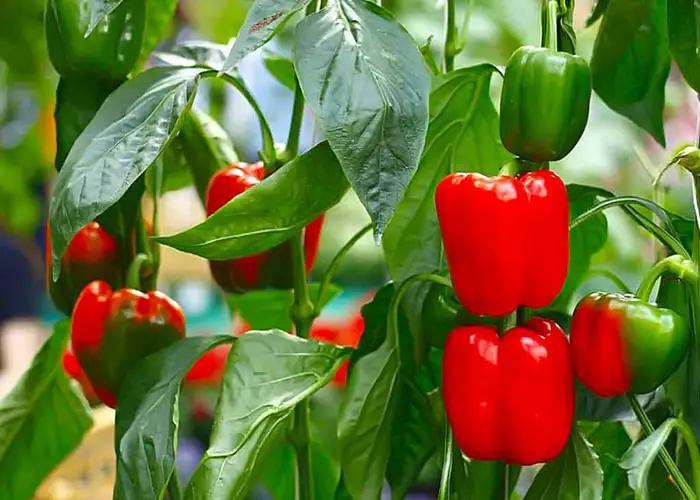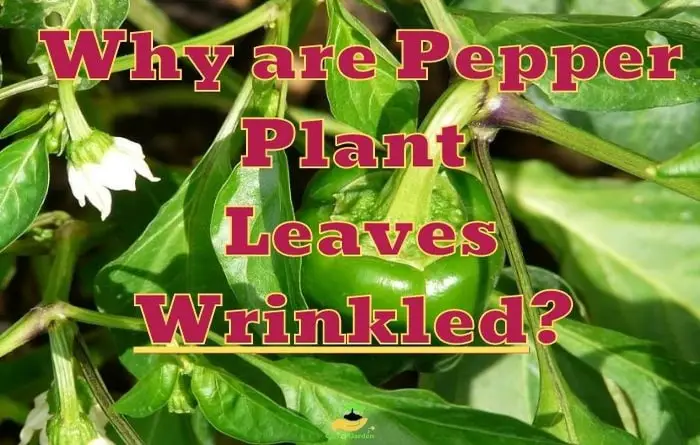Why are Pepper Plant Leaves Wrinkled? [9 Surprising Reasons]
One day I noticed that wrinkled leaves appeared on some of my pepper bushes. After some research, I found out that wrinkled or curled leaves are one of the most common problems pepper plant growers face. Curling leaves are a plant’s way of telling you something is wrong, so it’s important to figure out the cause and fix the problem.
Wrinkled leaves on pepper plants can be caused by a variety of factors, including nutrient deficiencies, improper watering, diseases such as tobacco mosaic virus or bacterial leaf spot, and environmental stressors such as high temperatures or exposure to direct sunlight. To prevent wrinkled leaves, ensure your pepper plants receive adequate water and nutrients, avoid over-fertilizing, and maintain consistent temperatures.
Causes Of Wrinkled Leaves Of A Pepper Plant
1. Nutrient Deficiencies
The first potential cause of wrinkled pepper leaves is a need for more nutrients. The leaves will look healthy if the plant gets enough nitrogen, phosphorus, or potassium. A fertilizer with a high percentage of these nutrients can help to perk up your plant.
It’s no secret that plants need nutrients to survive. Like humans and animals, plants need various nutrients to stay healthy and thrive. The deficiency of two primary nutrients in the pepper plant can cause leaves to wrinkle. These two nutrients are nitrogen and potassium.
Nitrogen is responsible for many different changes in pepper plants. It helps to grow the leaves and stems of the plant and produce chlorophyll.
Chlorophyll gives plants their green color. So, a lack of nitrogen can cause plants to become yellow or brown. Nitrogen is also compulsory for the production of proteins.
Potassium is another essential nutrient for the growth of pepper plants. Potassium boosts the growth of roots and flowers.
A potassium deficiency can cause pepper plant leaves to wrinkle and turn yellow or brown. A lack of potassium can also make plants more susceptible to diseases.
Treatment
| Nutrient Deficiency | Symptoms on Peppers | Treatment |
|---|---|---|
| Calcium (Ca) | Leaves curl downwards and appear thickened or distorted. Brown spots or necrosis may also appear at the tip or edges of the leaves. | Apply calcium-rich fertilizer, such as bone meal or gypsum, to the soil. Avoid over-fertilizing with nitrogen, as it can interfere with calcium absorption. |
| Magnesium (Mg) | Interveinal chlorosis (yellowing) between the veins of the leaves, which may curl upwards. | Apply magnesium sulfate (Epsom salt) to the soil or foliage. Use a balanced fertilizer that includes magnesium. |
| Potassium (K) | Margins of the leaves may curl upward or inward, and the leaves may appear wilted or scorched. | Apply potassium-rich fertilizer, such as potassium sulfate or potassium chloride, to the soil. Use a balanced fertilizer that includes potassium. |
| Boron (B) | Younger leaves may become twisted, wrinkled, and brittle, and may eventually die. The tips and edges of the leaves may also turn brown or black. | Apply boron-rich fertilizer, such as borax or boric acid, to the soil. Use caution not to over-apply, as boron can be toxic in large amounts. |
| Zinc (Zn) | Leaves may curl inward, become thickened or brittle, and develop yellow or white spots. | Apply zinc sulfate to the soil or foliage. Use a balanced fertilizer that includes zinc. |
| Nitrogen (N) | Older leaves turn yellow or pale green, and may curl and die prematurely. New growth may be stunted and distorted. | Apply nitrogen-rich fertilizer, such as ammonium nitrate or urea, to the soil. Use caution not to over-fertilize, as excess nitrogen can lead to other problems. |
| Phosphorus (P) | Leaves may appear dark green or bluish-green and may curl downward. Stems may become thin and weak, and the plant may produce few flowers or fruit. | Apply phosphorus-rich fertilizer, such as bone meal or superphosphate, to the soil. Use a balanced fertilizer that includes phosphorus. |
| Sulfur (S) | Yellowing of newer leaves, curling, and wilting; reduced plant growth. | Apply sulfur-rich fertilizer, such as elemental sulfur or ammonium sulfate, to the soil. Use caution not to over-apply, as sulfur can be toxic in large amounts. |
If you think your pepper plants are suffering from a nutrient deficiency, take a sample of the soil to a local nursery or garden center. They will test the ground and advise you on how to correct the problem.
After finding the cause of the wrinkled leaves, you can take steps to correct the problem. If the plant is too dry, water it deeply and regularly. If the problem is due to a nutrient deficiency, fertilize the pepper according to the manufacturer’s instructions.
2. High temperature and Dry air
High air temperatures can cause pepper plant leaves to become wrinkled due to a process called transpiration. Pepper plants use small pores called stomata to perform transpiration(losing water vapor from the leaves).
When the air temperature is high, the water in the pepper leaves evaporates more quickly, which causes the plant to lose more water through transpiration.
If the plant loses water too quickly and cannot replace it through its roots, the cells in the leaves can become dehydrated and shrink. This can cause the leaves to curl or wrinkle as the cells lose their turgor pressure and become less rigid.
Nightshade crops can suffer both from lack of sun and from severe overheating. A side effect in this case is lethargy of the pepper leaves. This applies to both peppers and tomatoes.
Therefore, if outright heat has set in outside the window and has not given up its position for several days now, during the daytime, provide the plants with a breathable shelter (thin spunbond, insect net, tulle), and spray them with warm water in the morning and evening. Mulch to keep moisture in the soil.
Treatment
To increase the level of air humidity near plantings, place water containers around the perimeter of the greenhouse.
Another important action is the ventilation of the greenhouse. In hot weather, leave the door and windows open, including at night. A more efficient way is to install an automatic greenhouse ventilation system.
If, after stopping the heat, the pepper leaves could not fully restore turgor, help them by using growth biostimulants.
3. Disease
The wrinkled leaves on a pepper plant are usually a sign of disease. Four main conditions can cause this symptom in peppers:
- Bacterial leaf spot.
- Alternaria leaf spot.
- Phytophthora blight.
- Septoria leaf spot.
Bacterial leaf spot is caused by the bacterium “Xanthomonas axonopodis.” It gives small, dark spots on the leaves of the pepper plants. The spots may eventually merge and cause the leaves to turn yellow and die.
Alternaria leaf spot is caused by the fungus “Alternaria solani.” It gives comparatively large, dark spots on the pepper’s leaves. This results in wrinkles on pepper leaves.
Phytophthora Blight is due to the fungus name “Phytophthora capsici” attack on the pepper plant creating small, dark spots. These dark spots may cause the wrinkled leaves to turn yellow and die.
Septoria leaf spot is caused by the fungus “Septoria lycopersici.” Due to this disease, the leaves of the pepper plant wrinkle, then turn yellow and die.
Table with Disease that cause Wrinkled Leaves of Peppers
| Disease Name | Symptoms | Treatment |
|---|---|---|
| Tobacco Mosaic Virus | Wrinkled, distorted, and mottled leaves with yellow or white streaks. Leaves may curl or appear stunted. | No cure exists for the virus. Remove infected plants and avoid smoking around healthy plants to prevent transmission. |
| Pepper Mottle Virus | Leaves may curl upwards and have a mottled appearance. Plants may be stunted or have reduced fruit production. | Remove infected plants and destroy them to prevent transmission. |
| Bacterial Leaf Spot | Brown or black spots with yellow halos may appear on leaves. Leaves may also curl or appear distorted. | Remove infected leaves and avoid overhead watering. Use copper-based fungicides to prevent further infection. |
| Alternaria Leaf Spot | Circular or irregular brown spots may appear on leaves. Leaves may curl or drop prematurely. | Remove infected leaves and avoid overhead watering. Use fungicides containing chlorothalonil or mancozeb to prevent further infection. |
| Phytophthora Blight | Leaves may wilt and curl downwards. Stems may have brown or black lesions. Roots may also rot. | Remove infected plants and avoid overhead watering. Improve soil drainage and use fungicides containing mefenoxam or metalaxyl to prevent further infection. |
| Septoria Leaf Spot | Small gray or brown spots with black borders may appear on leaves. Leaves may curl or drop prematurely. | Remove infected leaves and avoid overhead watering. Use fungicides containing chlorothalonil or mancozeb to prevent further infection. |
Treatment
Pepper plants are susceptible to many pests and conditions, including aphids, whiteflies, and fungal infections.
If you see problems in your pepper plant, you must treat them with an appropriate pesticide. You must treat the plant with a fungicide if you see signs of disease.
If temperature stress is the issue, protect it from extreme heat or cold. If herbicide injury is to blame, remove the affected leaves and wait for new growth.
4. Environmental Stress
One of the most common problems pepper plant growers face that lead to leaf wrinkling or curling is environmental stress.
Environmental stress is any abiotic or biotic factor that affects plant growth, development, or productivity.
- Abiotic stressors include light, temperature, water, and nutrients.
- Biotic stressors include herbivores, pathogens, and competition from other plants.
Several factors can contribute to this condition, including:
Drought stress: One of the most common causes of leaf wrinkling in pepper plants. When pepper plants don’t have enough water, their leaves will wilt, and wrinkling is often one of the first symptoms.
Nutrient stress: Another common cause of leaf wrinkling is nutrient stress. This happens when pepper plants do not get enough of certain nutrients, such as nitrogen, potassium, or phosphorus.
Temperature stress: Extreme temperatures also cause leaves to wrinkle. Hot and cold weather can cause plant stress and leaf wrinkling in pepper plants.
Light stress: Pepper plants need a certain amount of light to thrive; too much or too little can cause anxiety.
Herbicide stress: If herbicides are applied too heavily or to pepper plants that are already stressed, it can cause leaves to wrinkle.
Treatment
If you think that stress may cause your pepper plant’s leaves to curl, the first step is to identify the source of the stress. Once you know what is causing the stress, you can take steps to fix the problem.
For example, if your plants are getting too much sun, you can move them to a shady spot. If they are not getting enough water, you can increase how much you water them.
If stress is the cause of your pepper plant leaves curling, the second thing you should do is check the plant’s watering schedule. Make sure you’re watering sparingly or need more.
Too much water can cause the leaves to curl, while insufficient water can cause the leaves to wilt. Sticking your finger in the soil is the best way to tell if your plant needs water. If the soil is dry, it’s time to water.
5.Insufficient lighting
Pepper is quite picky about lighting. If it is not enough, it may turn out that the vein will grow faster compared to the plate itself.
Sunlight is essential for photosynthesis, the process in which pepper plants produce energy to support healthy growth, including the maintenance of turgor pressure in the cells of the leaves.
Therefore, without sunlight the pepper leaves become weak and wrinkled. This is especially common during the seedling stage.
Seedlings are trying to grow green mass in order to use light to the maximum. But growth is uneven, and the pepper stems become elongated and weak, which may further contribute to the wrinkling of the leaves.
Treatment
If peppers are grown in a greenhouse, it is necessary to add additional lighting including artificial grow lights . At the same time, you should not be particularly afraid, since this factor does not affect the yield.
Check the amount of sunlight your plant is getting. Pepper plants need at least six hours of sunlight per day. If your plant is not getting enough sunlight, the leaves will begin to curl. You can move the plant to a sunnier spot.
Additionally, ensuring that pepper plants are not overcrowded and have enough space between plants can help prevent competition for light and reduce the risk of wrinkled leaves due to lack of light.
6. Soil pH imbalances
If soil pH levels are too high or too low it will affect the pepper’s plant ability to absorb nutrients and water from the soil, leading to wrinkled or curled leaves.
The pH of your soil has a significant impact on your plants. It affects how well they can absorb nutrients from the soil, resist disease, and even the flavor of fruits and vegetables.
The soil pH is measured on a scale of 0 to 14, with 7 being neutral. A pH less than 7 is acidic, and a pH greater than 7 is alkaline. Several soil pH imbalances can occur. Pepper plants prefer a slightly acidic soil pH between 6.0 and 6.8.
A high pH level (alkaline) will prevent the absorption of certain nutrients like iron, manganese, and zinc, causing nutrient deficiency leading to abnormal growth and wrinkling or curling of leaves.
On the other hand, when the soil pH is too low (acidic), aluminum and other toxic elements may become more available to the plant. This can lead to root damage, which can cause the leaves to appear stunted, curled, or wrinkled.
Acidic and Alkaline Soil
The soil pH imbalance occurs when the pH is below 7.0. Acidic soil can be caused by many things, including:
- Excess rain
- Excess irrigation
- Excess fertilization
- Poor soil drainage
If your soil is too alkaline or acidic, it can cause problems for your pepper plants. Alkaline soils can make it difficult for plants to absorb nutrients, and acidic soils can make it difficult for plants to resist disease.
Treatment
To prevent wrinkled or curled leaves due to soil pH problems, it’s important to test the soil pH regularly and amend the soil as needed. The best way to test soil pH is with a soil test kit. You can buy these kits at most garden centers or online.
Adding lime to increase soil pH or sulfur to decrease soil pH can help adjust the pH level to the optimal range for pepper plants. It’s also important to ensure that pepper plants receive adequate nutrition through the use of balanced fertilizers and organic matter.
7. Overwatering
Overwatering is one of the most common problems when it comes to taking care of plants. It is often caused by a need to understand how much water plants need. Overwatering can lead to several problems, including:
1.Root Rot: This is caused by waterlogged soil, which prevents oxygen from reaching the roots. This can lead to the roots rotting and the plant eventually dying.
2.Leaf Yellowing or Dropping: This is caused by the lack of oxygen in the soil, which prevents the plant from taking in the nutrients it needs. This can cause the leaves to turn yellow and drop off.
3.Mold or Mildew: This is caused by the damp conditions caused by overwatering. Mold and mildew can cause the leaves to turn yellow or brown, eventually killing the plant.
Treatment
Overwatering is a common problem but can be easily avoided with some knowledge and care.
If you think you are overwatering your pepper plants, the first step is to check the soil and reassess your watering schedule. If it is waterlogged, remove the excess water and allow the soil to dry before watering again. Try cutting back on the frequency of watering and see if that helps.
With a little trial and error, you should find a schedule that works for your plants and keeps them healthy and happy.
8.Plant Edema
Pepper plant leaves can become wrinkled due to a condition called “plant edema”. In plant edema, the pepper plant takes up water faster than it can transpire through the leaves.
As a result, the cells in the leaves become swollen and engorged with water, which can cause the leaves to become thick, blistered, and wrinkled.
Plant edema occurs for several reasons, including;
- Overwatering
- High humidity
- Low light
- Poor soil drainage.
To prevent plant edema in peppers, it is essential to provide adequate soil drainage, avoid overwatering, and ensure proper ventilation and air circulation around the plant.
9.Lack of Water
One reason could be that the plant is not getting enough water. If the soil is dry, the leaves will wrinkle to conserve moisture. Make sure to water your pepper plant regularly, especially during hot weather.
Lack of water can cause wrinkled leaves on pepper plants because water is necessary for plants to maintain turgor pressure in their cells.
When a pepper plant does not receive enough water, it begins to lose water through transpiration more rapidly than it can take up water through its roots.
As a result, the cells in the leaves lose their turgor pressure and begin to wilt, which can cause the leaves to appear wrinkled or curled.
Treatment
If you suspect your pepper plant’s leaves are curling up due to a lack of water, the best action is to water the plant more frequently.
If the problem persists, you may need to adjust your watering schedule or add a humidity tray to the room where the plant grows.
Should I Remove Curled or Wrinkled Leaves from Pepper Plants?

Pepper plants are popular in many home gardens and commercial farms. However, they are susceptible to various diseases and pests that can cause the leaves to curl.
As a gardener, you may wonder whether you should remove curled leaves from pepper plants. The answer depends on the reason for the curling.
Removing pepper leaves is unnecessary if they are curled due to environmental stress, such as high temperatures or low humidity.
Instead, you should address the underlying ecological issue to prevent further leaf curling. For example, you can provide shade to protect the plants from excessive heat or increase humidity by misting the leaves regularly.
On the other hand, if the pepper leaves are curled due to a pest infestation, such as aphids or spider mites, you should remove the affected leaves.
Pests can spread quickly and cause significant plant damage if left untreated. Removing the affected leaves can help to prevent the problems from spreading to other parts of the plant and allow the plant to focus its resources on healthy growth.
Lastly, if the pepper plant leaves are curled due to a fungal or bacterial infection, you should also remove the affected leaves.
Fungal and bacterial infections can spread rapidly, causing significant damage to the plant and potentially killing it. Removing the affected leaves can help to prevent the disease from spreading and promote healthy growth.
Whether or not to remove curled leaves from pepper plants depends on the reason for the curling. If the curling is due to environmental stress, removing the leaves is unnecessary.
However, if the curling is due to pests or infections, removing the affected leaves can help to prevent further damage and promote healthy growth.
How to Prevent Pepper Leaves from Wrinkling
1. Water your pepper plant regularly. Peppers need a lot of water, so keep the soil moist. But be careful not to overwater, as this can lead to root rot.
2. Watering is done strictly under the root, avoiding water on the leaves. If the soil is too wet, you should not water it again, it is better to wait until it dries.
3. Place your pepper plant in a sunny spot. Peppers need at least six hours of sunlight daily, so choose an area with plenty of light in your home.
4. Fertilize your pepper plant every two weeks. Use a fertilizer that’s high in nitrogen to help promote growth.
5. Complex fertilizers are periodically applied to the soil, which must necessarily include potassium. During the season, you need to do at least 4 dressings, especially at the stage of flowering and fruiting (interval 2-3 weeks).
6. Prune your pepper plant regularly. Remove any dead or dying leaves or stems. This will help encourage new growth.
7. If the leaves of the seedlings curl, at a height of 40-50 cm from the upper leaves, you need to install a phytolamp and illuminate the seedlings until the total daylight hours are 13-14 hours. But gradually the highlighting time is reduced, because otherwise the seedlings will begin to stretch.
8. Watch for pests. Aphids, whiteflies, and mealybugs are all common pests that can infest pepper plants. If you see any of these pests, treat them immediately.
Following these tips can help ensure that your pepper plant stays healthy and produces plenty of peppers. Enjoy!
Conclusion
As you can see, there are some reasons why pepper plant leaves may curl. You can figure out what’s causing the wrinkled leaves on your pepper plant with a little investigation. Once you know the cause, you can take steps to fix the problem and get your plants back to their healthy selves.
Frequently Asked Questions
If you’re noticing your pepper plant leaves curling, it’s likely due to one of several reasons. The most common reason for pepper plant leaves to curl is due to stress. Stress can be caused by several factors, including too much or too little water, too much sunlight, and pests or diseases.
Overwatering can cause pepper plant leaves to become wrinkled due to a lack of oxygen in the soil that can lead to root rot. When the roots are damaged or unable to take up water properly, the leaves may appear wilted, yellow, or wrinkled.
Wrinkled leaves on a pepper plant can affect fruit production by reducing the plant’s ability to photosynthesize and produce energy. Additionally, some diseases or pest problems that cause wrinkled leaves can also directly affect fruit production. It’s important to address the underlying problem to prevent further damage to the plant and ensure healthy fruit production.
To determine if wrinkled leaves on a pepper plant are due to a disease or pest problem, it’s important to look for other symptoms such as spots, discoloration, or unusual growth patterns. Additionally, examining the undersides of leaves for signs of pests such as aphids, spider mites, or whiteflies can help diagnose the problem. It may be helpful to consult with a gardening expert or plant pathologist for a proper diagnosis.




